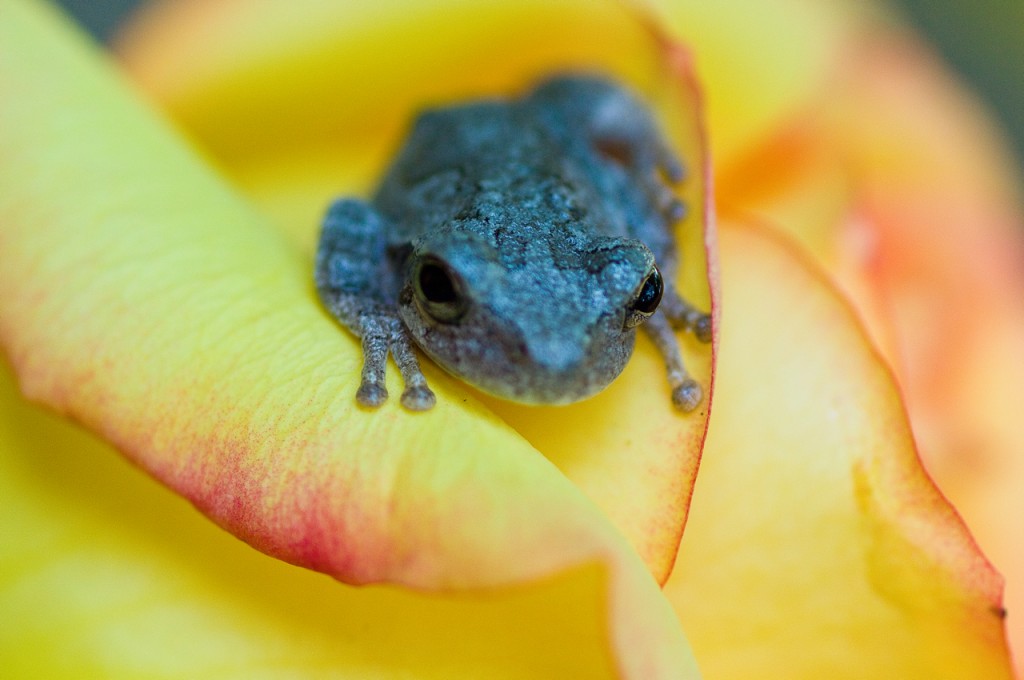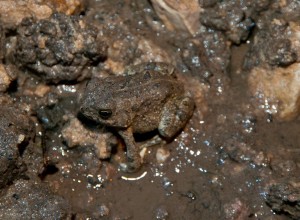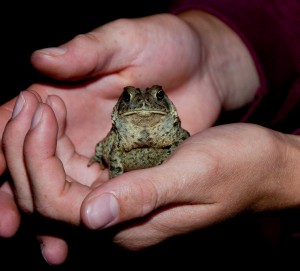Frogs and Toads Serenade the Spring Nights

Gray tree frogs will cling to window screens and make short trills. Photo courtesy of Tom Rollins, ThomasRollinsPhotography.com
Love is in the air. It isn’t just the proverbial birds and bees making song in hopes of making love, though the dawn chorus of songbirds and midday hum of bees, is all about establishing territories and getting on with the springtime necessity of homemaking and raising a new generation. Beginning as early as February, full symphonies of frogs and toads sing and welcome in warm weather.
Along with newts and salamanders, frogs and toads are classed as amphibians, a word derived from Greek meaning two lives and signifying the distinguishing characteristic of all amphibians: the two distinct stages in their life cycle. Amphibian eggs are laid in water and hatch into aquatic young called larvae. Upon reaching maturity, amphibians leave the water and take up a terrestrial or semi-aquatic existence. Frogs and toads belong to the biological order Anura. Frogs and toads have a unique appearance with short, squat bodies, large heads and very large hind legs. They lack scales and have a thin, respiratory skin covered with a layer of moisture secreted by special glands.
All frogs and toads are cold-blooded, secretive, generally nocturnal, and require a damp or wet environment to live and breed. All female frogs and toads lay jelly-like eggs in water, which then are directly fertilized by the males. Eggs hatch into tadpoles, which are aquatic, vegetarian-eating larval forms that do not resemble the adult forms. Later, the tadpoles transform into juveniles – miniature adults — which grow into full mature size. Unlike vegetarian tadpoles, adult frogs and toads will eat anything animal they can get their long, flapper-like, tongues around. Most eat insects, invertebrates and small crustaceans.

Fowler's toads make short trills that sound like a "waaw." Photo courtesy Tom Rollins, ThomasRollinsPhotography.com
Our region is a frog and toad heaven, with innumerable sinkhole ponds and springtime temporary wet ground in the bluff lands, and extensive wetlands in the floodplain on the bottoms. The best wetland habitat for frogs and toads is shallower water, without the presence of fish predators, with plenty of aquatic cover, such as downed logs, fallen branches, leaf litter, and grass and tree-lined edges.
As you might expect with such good habitat readily available, our area is home to 16 species of frogs and toads: Cricket frog, Cope’s gray treefrog, eastern gray treefrog, spring peeper, western chorus frog, plains leopard frog, bullfrog, green frog, pickerel frog, southern leopard frog, wood frog, Strecker’s chorus frog, spadefoot toad, and eastern narrowmouth toad (despite the common names, both actually are frogs); and, American toad and Fowler’s toad. They collectively serenade our springtime and summertime evenings with full orchestral scores of syncopated call notes, reminding us that they share our bluffs and bottoms homeland, and warming weather carries the imperatives of a new breeding season.
Spring peepers and wood frogs are the first frogs to breed in our area, usually starting by late February. Both, like many frogs, have a kind of antifreeze in their blood, and can withstand being totally frozen in the soil of their winter burrows. The earliest spring rains and temperatures above 50 F awaken both to breeding. Spring peepers are about 1” long and collect in the grasses and bushes around our numerous sinkhole ponds to breed. Their clear, high-pitched “peeps,” about one per second, are usually the first calls of spring. Wood frogs, more secretive and harder to hear, are 1.5”-2” long, and breed in small woodland ponds, puddles or vernal pools. They live and hide in forest leaf litter. Their breeding calls are a soft, rapid clucking or quacking sound, much like a duck.
Chorus frogs also begin calling in early springtime, often in late February if the weather warms sufficiently. Indeed, for some people, the sound of chorus frogs’ call – rather like a fingernail strumming the teeth of a comb – marks the start of spring.
Leopard frogs and cricket frogs generally begin calling – depending on warmth and the amount of spring rains – in March or April. The “chuckles and groans” of southern leopard frogs and the “chuck-chuck-chuck” of plains leopard frogs can be difficult to distinguish. By late April, cricket frogs join the chorus, providing short, cricket-like clicks that sound a bit like knocking two small pebbles together. The low snoring sound of pickerel frogs, and the guttural trills of gray treefrogs add to spring evening choruses by late April or early May. At the same time, bullfrogs add their “jug-a-rum” calls to punctuate the night and defend their territories against other males.

American toads give a long high-pitched call. This American toad posed for a portrait in Bob Weck's hands during the 2011 BioBlitz at Salt Lick Point Land & Water Reserve. Photo courtesy Tom Rollins, ThomasRollinsPhotography.com
Our two bluff lands toad species add their voices to the amphibian symphony beginning in April. Fowler’s toads sing a short “waaw” call while American toads sustain a long, high-pitched call. Each individual’s call may last 20-30 seconds so that a group of American toads calling may seem like a long trilling chant of nearly endless repetition.
Heavy rains at any time from late April through September may bring on a short-lived explosion of vocal activity, breeding, and rapid maturation from eastern spadefoot toads. This species, not recorded in Monroe County since 1980, lives underground most of the year and breeds in ephemeral ponds. After a heavy rain produces temporary ponds, their low-pitched explosive groans occur for a brief period. Eggs hatch in just a few days and tadpoles transform in only two to three weeks.
Among the last of the frogs of our area to begin calling and their breeding seasons are the green treefrogs and eastern narrowmouth toads. Green treefrogs breed from late May through September. The males will call, sometimes in large numbers, while perched on pondshore plants. They give series of metallic honks, sometimes compared to old-fashioned cowbells or, even, a dog’s bark. Eastern narrowmouth toads have an alternate name, “sheepfrog,” that describes their call, a short, high-pitched “baaa,” sounding similar to a lamb’s call. Eastern narrowmouths are rarely seen, as they prefer to be under almost anything, including stumps, rocks, logs, and bark. They breed in either permanent ponds or ephemeral waters. They are notable as they are among the very few amphibian species that regularly feed on ants and sometimes are found well away from watery environs, including glades at the tops of our bluff lands.
In late May, nearly all members of our bluff lands’ frog and toad symphony orchestras are tuned up and performing nightly. An evening at water’s edge can prove to be a musical improvisational jam session, on par with a nighttime performance of the Bud Light Brigade or the Waterloo German Band. Clifftop is hosting a Frog Frolic on full-moon Saturday May 31st, from 8 to 10 PM. Bob Weck, herpetologist and head of Southwestern Illinois College’s Biology Department, will lead the hike.
The frog frolic is free and open to the public. Pre-registration is required by May 29th at clifftop@htc.net or 458-4674. You’ll have to pre-register since we haven’t picked the wetlands yet: we’re watching water levels and listening to orchestral rehearsals before finalizing the hike location.
And, if you are interested in improving wetland habitat to sponsor your own symphony orchestral hall please see the study “Amphibians in Sinkhole Ponds & Best Management Practices” posted on our science and research section by clicking here: Best Management Practices.
CLIFFTOP, a local nonprofit organization, is focused on preserving and protecting area bluff lands.
A version of this article appeared in the 16 May 2014 edition of the Monroe County Independent.
© 2014 all content rights reserved Clifftop NFP
Comments are currently closed.
